Competitive Analysis of IKEA and Challenges Faced in Trading Across Borders
VerifiedAdded on 2022/12/15
|15
|5386
|449
AI Summary
This report provides a competitive analysis of IKEA and discusses the challenges faced by the company when trading across borders. It includes an explanation of how a business activity of the firm provides competitive advantage and explores the need for enhancing their business with theoretical tools.
Contribute Materials
Your contribution can guide someone’s learning journey. Share your
documents today.
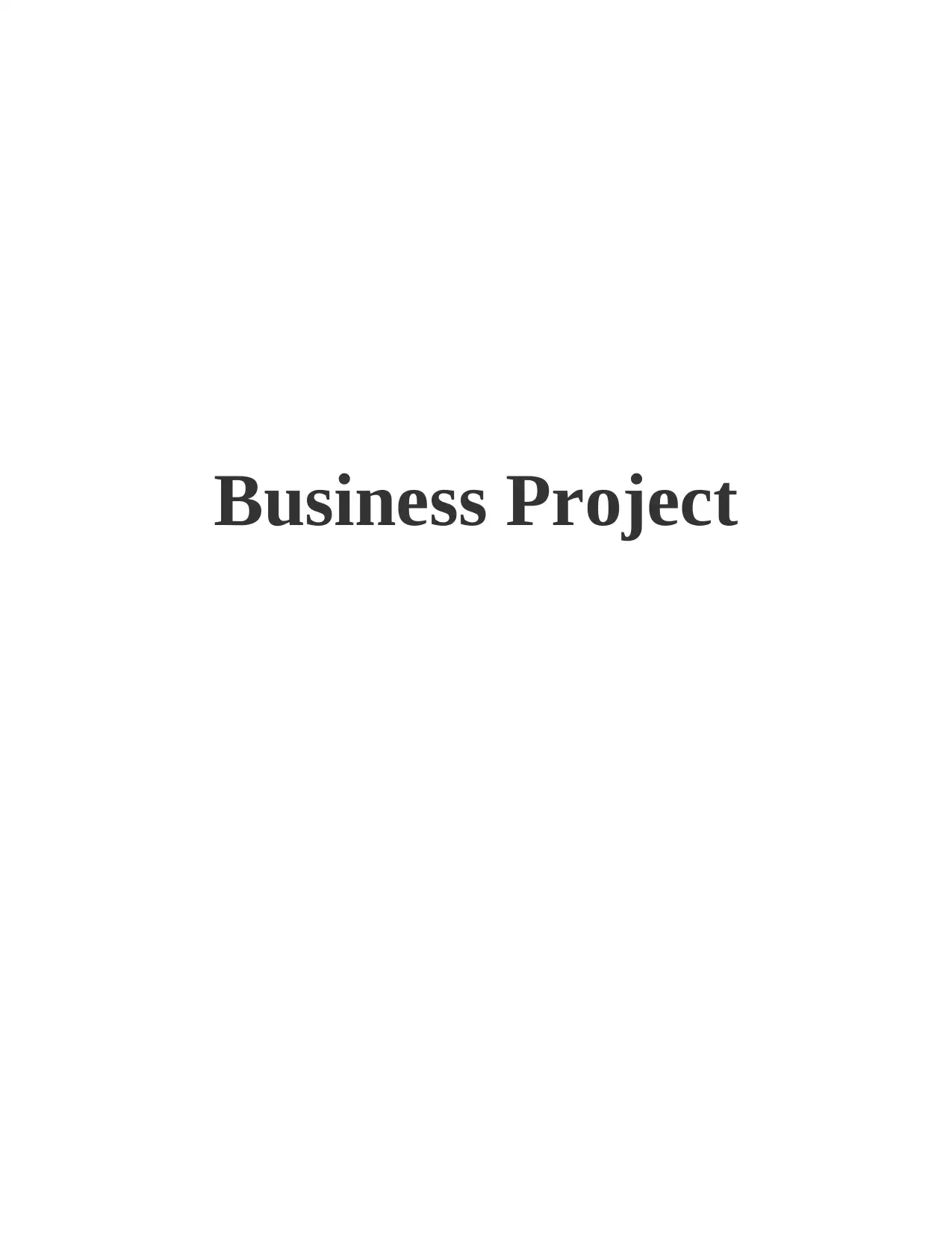
Business Project
Secure Best Marks with AI Grader
Need help grading? Try our AI Grader for instant feedback on your assignments.
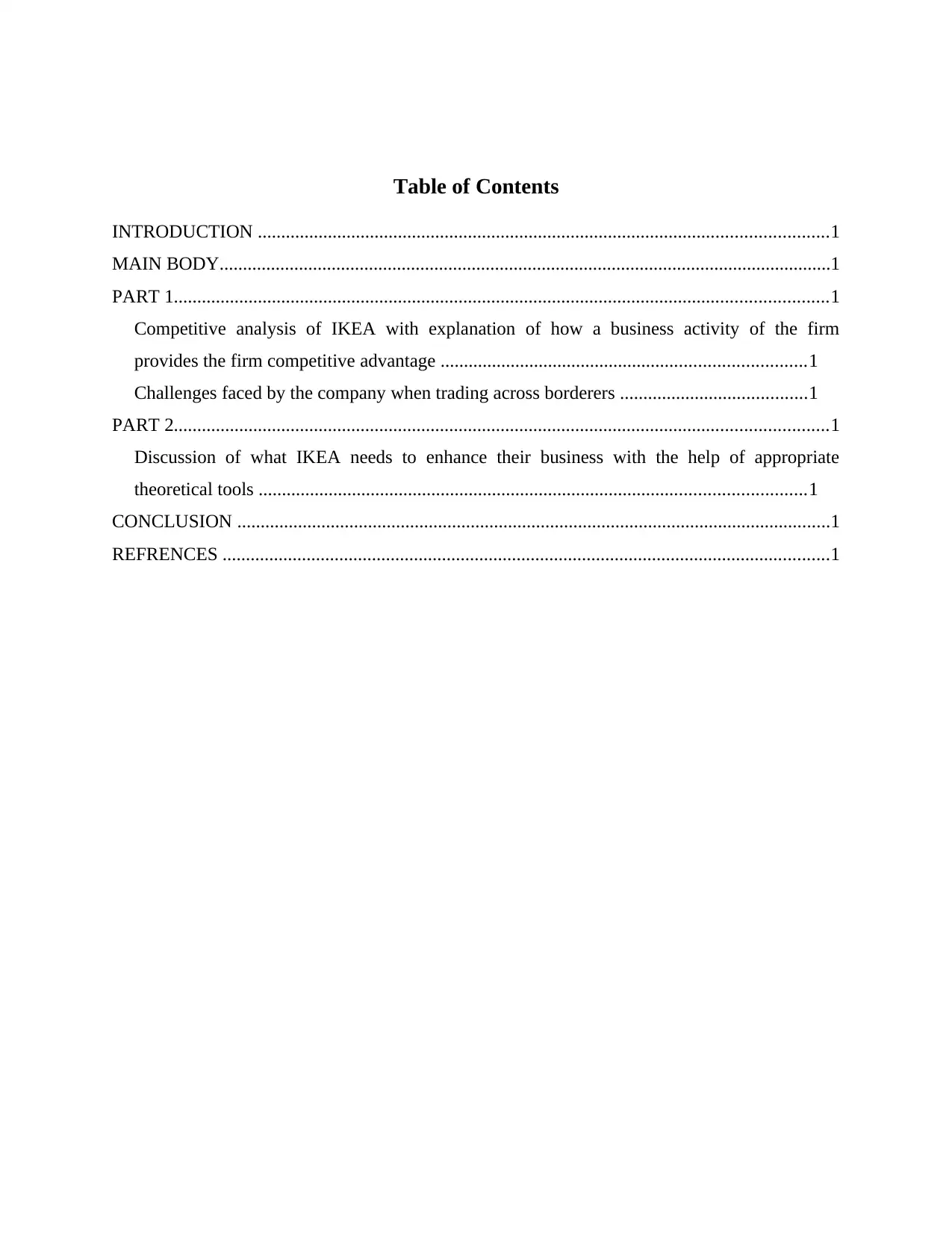
Table of Contents
INTRODUCTION ..........................................................................................................................1
MAIN BODY...................................................................................................................................1
PART 1............................................................................................................................................1
Competitive analysis of IKEA with explanation of how a business activity of the firm
provides the firm competitive advantage ..............................................................................1
Challenges faced by the company when trading across borderers ........................................1
PART 2............................................................................................................................................1
Discussion of what IKEA needs to enhance their business with the help of appropriate
theoretical tools .....................................................................................................................1
CONCLUSION ...............................................................................................................................1
REFRENCES ..................................................................................................................................1
INTRODUCTION ..........................................................................................................................1
MAIN BODY...................................................................................................................................1
PART 1............................................................................................................................................1
Competitive analysis of IKEA with explanation of how a business activity of the firm
provides the firm competitive advantage ..............................................................................1
Challenges faced by the company when trading across borderers ........................................1
PART 2............................................................................................................................................1
Discussion of what IKEA needs to enhance their business with the help of appropriate
theoretical tools .....................................................................................................................1
CONCLUSION ...............................................................................................................................1
REFRENCES ..................................................................................................................................1
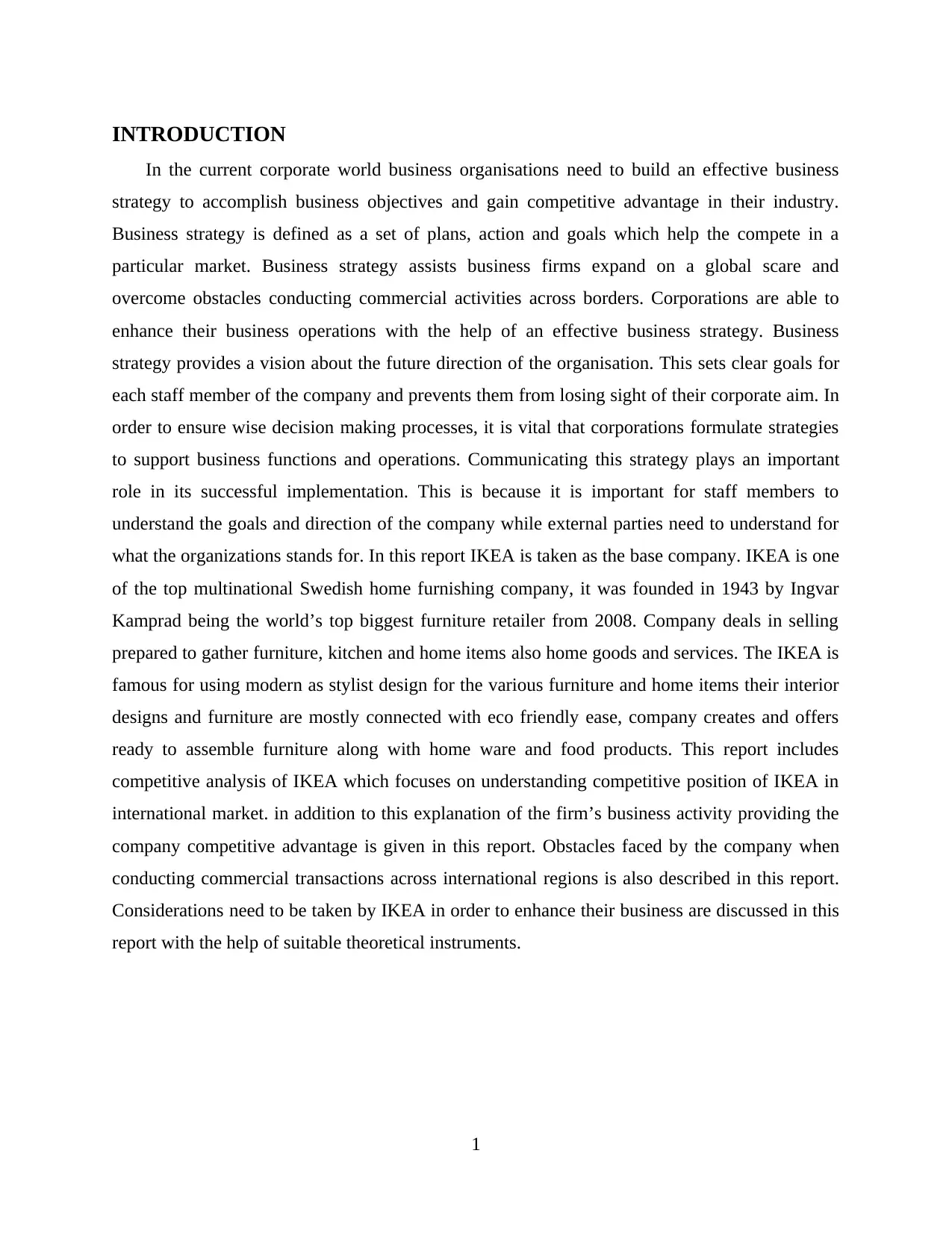
INTRODUCTION
In the current corporate world business organisations need to build an effective business
strategy to accomplish business objectives and gain competitive advantage in their industry.
Business strategy is defined as a set of plans, action and goals which help the compete in a
particular market. Business strategy assists business firms expand on a global scare and
overcome obstacles conducting commercial activities across borders. Corporations are able to
enhance their business operations with the help of an effective business strategy. Business
strategy provides a vision about the future direction of the organisation. This sets clear goals for
each staff member of the company and prevents them from losing sight of their corporate aim. In
order to ensure wise decision making processes, it is vital that corporations formulate strategies
to support business functions and operations. Communicating this strategy plays an important
role in its successful implementation. This is because it is important for staff members to
understand the goals and direction of the company while external parties need to understand for
what the organizations stands for. In this report IKEA is taken as the base company. IKEA is one
of the top multinational Swedish home furnishing company, it was founded in 1943 by Ingvar
Kamprad being the world’s top biggest furniture retailer from 2008. Company deals in selling
prepared to gather furniture, kitchen and home items also home goods and services. The IKEA is
famous for using modern as stylist design for the various furniture and home items their interior
designs and furniture are mostly connected with eco friendly ease, company creates and offers
ready to assemble furniture along with home ware and food products. This report includes
competitive analysis of IKEA which focuses on understanding competitive position of IKEA in
international market. in addition to this explanation of the firm’s business activity providing the
company competitive advantage is given in this report. Obstacles faced by the company when
conducting commercial transactions across international regions is also described in this report.
Considerations need to be taken by IKEA in order to enhance their business are discussed in this
report with the help of suitable theoretical instruments.
1
In the current corporate world business organisations need to build an effective business
strategy to accomplish business objectives and gain competitive advantage in their industry.
Business strategy is defined as a set of plans, action and goals which help the compete in a
particular market. Business strategy assists business firms expand on a global scare and
overcome obstacles conducting commercial activities across borders. Corporations are able to
enhance their business operations with the help of an effective business strategy. Business
strategy provides a vision about the future direction of the organisation. This sets clear goals for
each staff member of the company and prevents them from losing sight of their corporate aim. In
order to ensure wise decision making processes, it is vital that corporations formulate strategies
to support business functions and operations. Communicating this strategy plays an important
role in its successful implementation. This is because it is important for staff members to
understand the goals and direction of the company while external parties need to understand for
what the organizations stands for. In this report IKEA is taken as the base company. IKEA is one
of the top multinational Swedish home furnishing company, it was founded in 1943 by Ingvar
Kamprad being the world’s top biggest furniture retailer from 2008. Company deals in selling
prepared to gather furniture, kitchen and home items also home goods and services. The IKEA is
famous for using modern as stylist design for the various furniture and home items their interior
designs and furniture are mostly connected with eco friendly ease, company creates and offers
ready to assemble furniture along with home ware and food products. This report includes
competitive analysis of IKEA which focuses on understanding competitive position of IKEA in
international market. in addition to this explanation of the firm’s business activity providing the
company competitive advantage is given in this report. Obstacles faced by the company when
conducting commercial transactions across international regions is also described in this report.
Considerations need to be taken by IKEA in order to enhance their business are discussed in this
report with the help of suitable theoretical instruments.
1
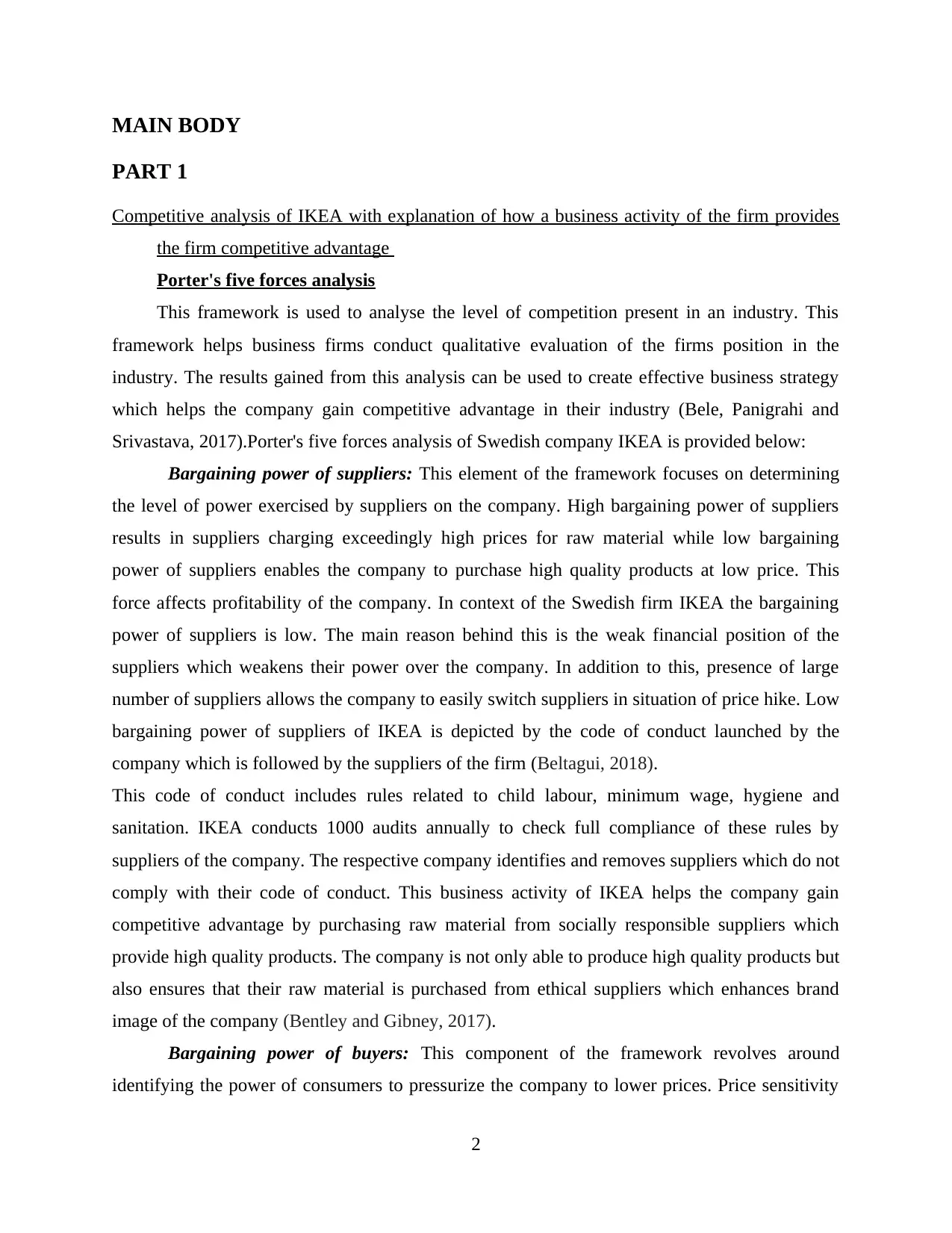
MAIN BODY
PART 1
Competitive analysis of IKEA with explanation of how a business activity of the firm provides
the firm competitive advantage
Porter's five forces analysis
This framework is used to analyse the level of competition present in an industry. This
framework helps business firms conduct qualitative evaluation of the firms position in the
industry. The results gained from this analysis can be used to create effective business strategy
which helps the company gain competitive advantage in their industry (Bele, Panigrahi and
Srivastava, 2017).Porter's five forces analysis of Swedish company IKEA is provided below:
Bargaining power of suppliers: This element of the framework focuses on determining
the level of power exercised by suppliers on the company. High bargaining power of suppliers
results in suppliers charging exceedingly high prices for raw material while low bargaining
power of suppliers enables the company to purchase high quality products at low price. This
force affects profitability of the company. In context of the Swedish firm IKEA the bargaining
power of suppliers is low. The main reason behind this is the weak financial position of the
suppliers which weakens their power over the company. In addition to this, presence of large
number of suppliers allows the company to easily switch suppliers in situation of price hike. Low
bargaining power of suppliers of IKEA is depicted by the code of conduct launched by the
company which is followed by the suppliers of the firm (Beltagui, 2018).
This code of conduct includes rules related to child labour, minimum wage, hygiene and
sanitation. IKEA conducts 1000 audits annually to check full compliance of these rules by
suppliers of the company. The respective company identifies and removes suppliers which do not
comply with their code of conduct. This business activity of IKEA helps the company gain
competitive advantage by purchasing raw material from socially responsible suppliers which
provide high quality products. The company is not only able to produce high quality products but
also ensures that their raw material is purchased from ethical suppliers which enhances brand
image of the company (Bentley and Gibney, 2017).
Bargaining power of buyers: This component of the framework revolves around
identifying the power of consumers to pressurize the company to lower prices. Price sensitivity
2
PART 1
Competitive analysis of IKEA with explanation of how a business activity of the firm provides
the firm competitive advantage
Porter's five forces analysis
This framework is used to analyse the level of competition present in an industry. This
framework helps business firms conduct qualitative evaluation of the firms position in the
industry. The results gained from this analysis can be used to create effective business strategy
which helps the company gain competitive advantage in their industry (Bele, Panigrahi and
Srivastava, 2017).Porter's five forces analysis of Swedish company IKEA is provided below:
Bargaining power of suppliers: This element of the framework focuses on determining
the level of power exercised by suppliers on the company. High bargaining power of suppliers
results in suppliers charging exceedingly high prices for raw material while low bargaining
power of suppliers enables the company to purchase high quality products at low price. This
force affects profitability of the company. In context of the Swedish firm IKEA the bargaining
power of suppliers is low. The main reason behind this is the weak financial position of the
suppliers which weakens their power over the company. In addition to this, presence of large
number of suppliers allows the company to easily switch suppliers in situation of price hike. Low
bargaining power of suppliers of IKEA is depicted by the code of conduct launched by the
company which is followed by the suppliers of the firm (Beltagui, 2018).
This code of conduct includes rules related to child labour, minimum wage, hygiene and
sanitation. IKEA conducts 1000 audits annually to check full compliance of these rules by
suppliers of the company. The respective company identifies and removes suppliers which do not
comply with their code of conduct. This business activity of IKEA helps the company gain
competitive advantage by purchasing raw material from socially responsible suppliers which
provide high quality products. The company is not only able to produce high quality products but
also ensures that their raw material is purchased from ethical suppliers which enhances brand
image of the company (Bentley and Gibney, 2017).
Bargaining power of buyers: This component of the framework revolves around
identifying the power of consumers to pressurize the company to lower prices. Price sensitivity
2
Secure Best Marks with AI Grader
Need help grading? Try our AI Grader for instant feedback on your assignments.
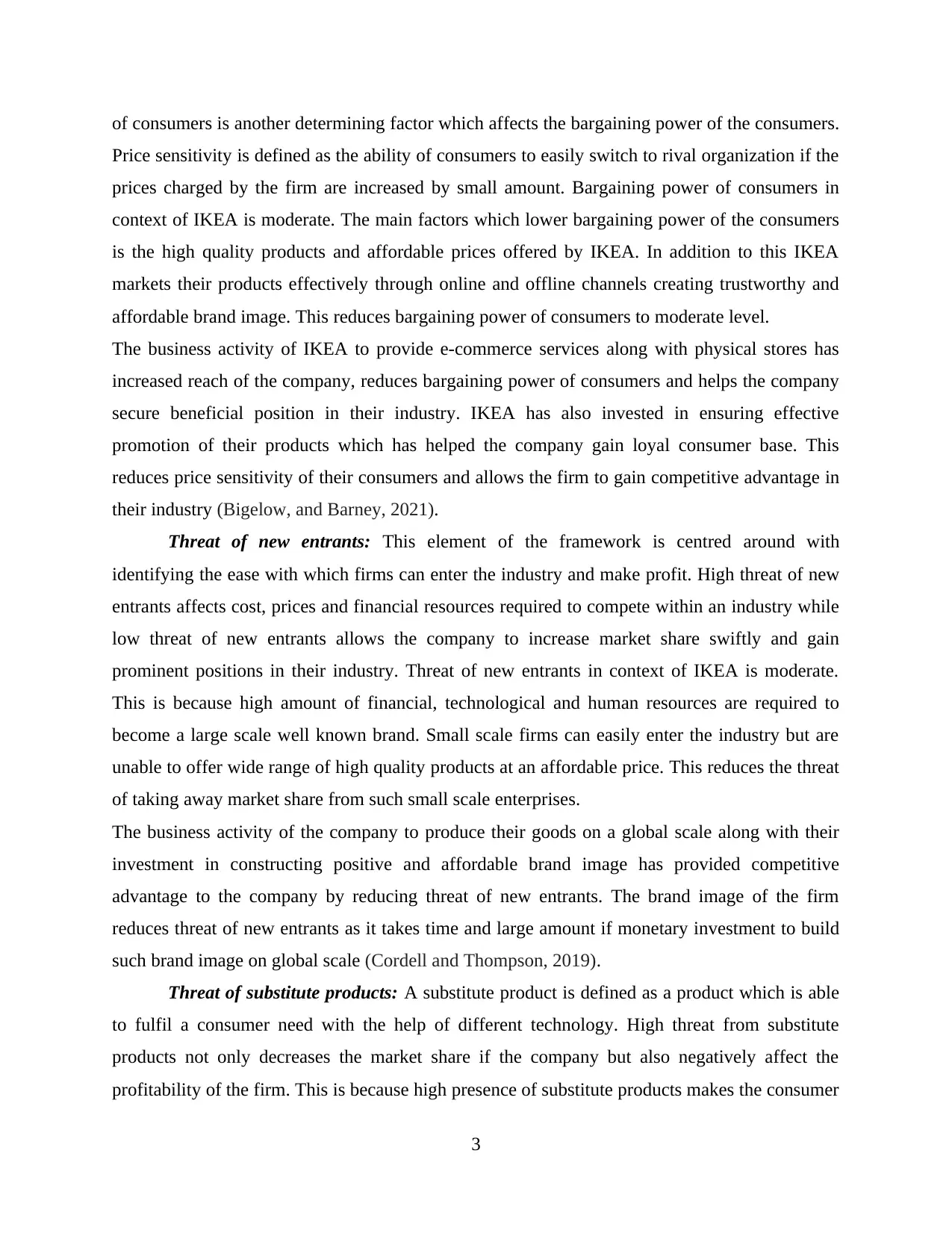
of consumers is another determining factor which affects the bargaining power of the consumers.
Price sensitivity is defined as the ability of consumers to easily switch to rival organization if the
prices charged by the firm are increased by small amount. Bargaining power of consumers in
context of IKEA is moderate. The main factors which lower bargaining power of the consumers
is the high quality products and affordable prices offered by IKEA. In addition to this IKEA
markets their products effectively through online and offline channels creating trustworthy and
affordable brand image. This reduces bargaining power of consumers to moderate level.
The business activity of IKEA to provide e-commerce services along with physical stores has
increased reach of the company, reduces bargaining power of consumers and helps the company
secure beneficial position in their industry. IKEA has also invested in ensuring effective
promotion of their products which has helped the company gain loyal consumer base. This
reduces price sensitivity of their consumers and allows the firm to gain competitive advantage in
their industry (Bigelow, and Barney, 2021).
Threat of new entrants: This element of the framework is centred around with
identifying the ease with which firms can enter the industry and make profit. High threat of new
entrants affects cost, prices and financial resources required to compete within an industry while
low threat of new entrants allows the company to increase market share swiftly and gain
prominent positions in their industry. Threat of new entrants in context of IKEA is moderate.
This is because high amount of financial, technological and human resources are required to
become a large scale well known brand. Small scale firms can easily enter the industry but are
unable to offer wide range of high quality products at an affordable price. This reduces the threat
of taking away market share from such small scale enterprises.
The business activity of the company to produce their goods on a global scale along with their
investment in constructing positive and affordable brand image has provided competitive
advantage to the company by reducing threat of new entrants. The brand image of the firm
reduces threat of new entrants as it takes time and large amount if monetary investment to build
such brand image on global scale (Cordell and Thompson, 2019).
Threat of substitute products: A substitute product is defined as a product which is able
to fulfil a consumer need with the help of different technology. High threat from substitute
products not only decreases the market share if the company but also negatively affect the
profitability of the firm. This is because high presence of substitute products makes the consumer
3
Price sensitivity is defined as the ability of consumers to easily switch to rival organization if the
prices charged by the firm are increased by small amount. Bargaining power of consumers in
context of IKEA is moderate. The main factors which lower bargaining power of the consumers
is the high quality products and affordable prices offered by IKEA. In addition to this IKEA
markets their products effectively through online and offline channels creating trustworthy and
affordable brand image. This reduces bargaining power of consumers to moderate level.
The business activity of IKEA to provide e-commerce services along with physical stores has
increased reach of the company, reduces bargaining power of consumers and helps the company
secure beneficial position in their industry. IKEA has also invested in ensuring effective
promotion of their products which has helped the company gain loyal consumer base. This
reduces price sensitivity of their consumers and allows the firm to gain competitive advantage in
their industry (Bigelow, and Barney, 2021).
Threat of new entrants: This element of the framework is centred around with
identifying the ease with which firms can enter the industry and make profit. High threat of new
entrants affects cost, prices and financial resources required to compete within an industry while
low threat of new entrants allows the company to increase market share swiftly and gain
prominent positions in their industry. Threat of new entrants in context of IKEA is moderate.
This is because high amount of financial, technological and human resources are required to
become a large scale well known brand. Small scale firms can easily enter the industry but are
unable to offer wide range of high quality products at an affordable price. This reduces the threat
of taking away market share from such small scale enterprises.
The business activity of the company to produce their goods on a global scale along with their
investment in constructing positive and affordable brand image has provided competitive
advantage to the company by reducing threat of new entrants. The brand image of the firm
reduces threat of new entrants as it takes time and large amount if monetary investment to build
such brand image on global scale (Cordell and Thompson, 2019).
Threat of substitute products: A substitute product is defined as a product which is able
to fulfil a consumer need with the help of different technology. High threat from substitute
products not only decreases the market share if the company but also negatively affect the
profitability of the firm. This is because high presence of substitute products makes the consumer
3
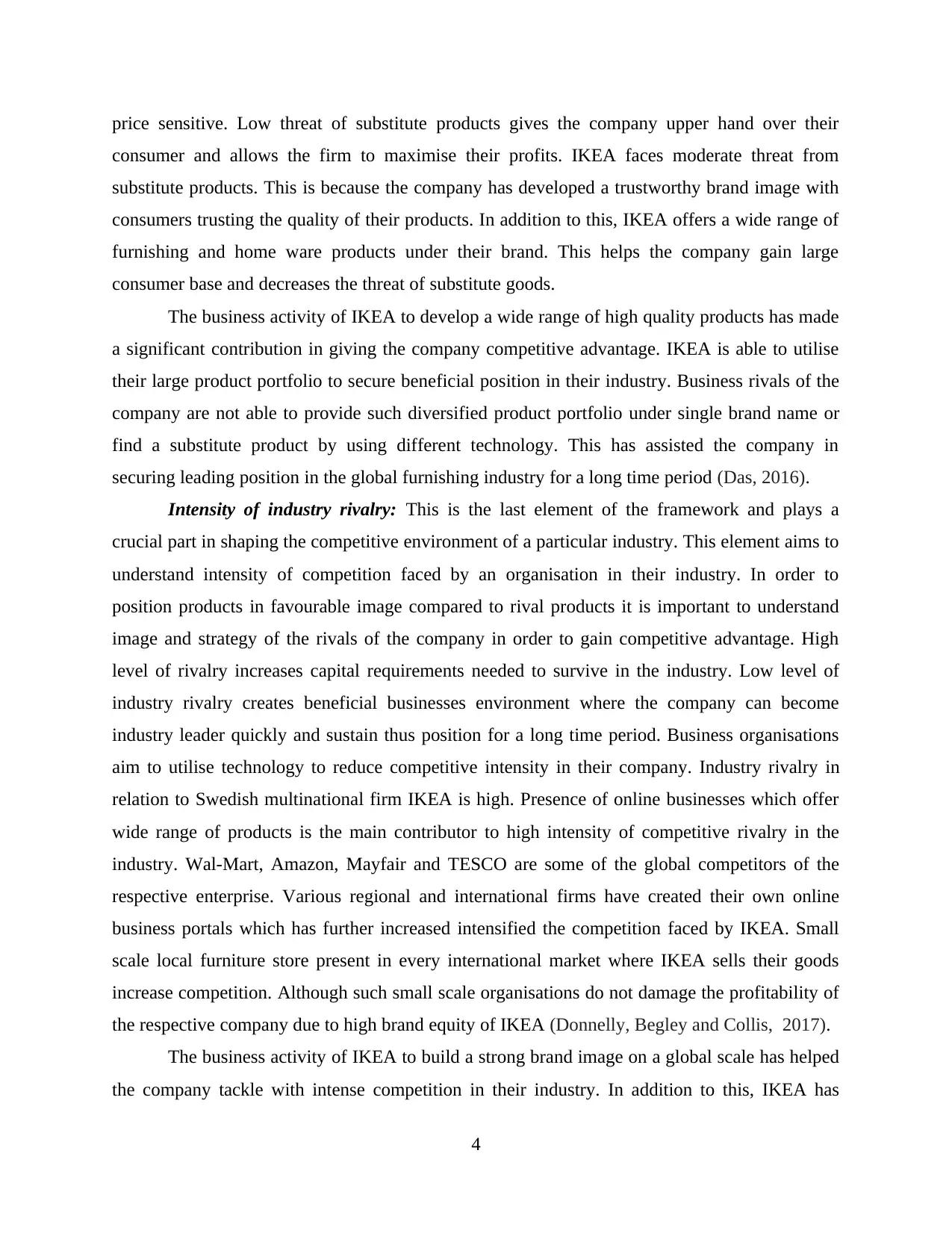
price sensitive. Low threat of substitute products gives the company upper hand over their
consumer and allows the firm to maximise their profits. IKEA faces moderate threat from
substitute products. This is because the company has developed a trustworthy brand image with
consumers trusting the quality of their products. In addition to this, IKEA offers a wide range of
furnishing and home ware products under their brand. This helps the company gain large
consumer base and decreases the threat of substitute goods.
The business activity of IKEA to develop a wide range of high quality products has made
a significant contribution in giving the company competitive advantage. IKEA is able to utilise
their large product portfolio to secure beneficial position in their industry. Business rivals of the
company are not able to provide such diversified product portfolio under single brand name or
find a substitute product by using different technology. This has assisted the company in
securing leading position in the global furnishing industry for a long time period (Das, 2016).
Intensity of industry rivalry: This is the last element of the framework and plays a
crucial part in shaping the competitive environment of a particular industry. This element aims to
understand intensity of competition faced by an organisation in their industry. In order to
position products in favourable image compared to rival products it is important to understand
image and strategy of the rivals of the company in order to gain competitive advantage. High
level of rivalry increases capital requirements needed to survive in the industry. Low level of
industry rivalry creates beneficial businesses environment where the company can become
industry leader quickly and sustain thus position for a long time period. Business organisations
aim to utilise technology to reduce competitive intensity in their company. Industry rivalry in
relation to Swedish multinational firm IKEA is high. Presence of online businesses which offer
wide range of products is the main contributor to high intensity of competitive rivalry in the
industry. Wal-Mart, Amazon, Mayfair and TESCO are some of the global competitors of the
respective enterprise. Various regional and international firms have created their own online
business portals which has further increased intensified the competition faced by IKEA. Small
scale local furniture store present in every international market where IKEA sells their goods
increase competition. Although such small scale organisations do not damage the profitability of
the respective company due to high brand equity of IKEA (Donnelly, Begley and Collis, 2017).
The business activity of IKEA to build a strong brand image on a global scale has helped
the company tackle with intense competition in their industry. In addition to this, IKEA has
4
consumer and allows the firm to maximise their profits. IKEA faces moderate threat from
substitute products. This is because the company has developed a trustworthy brand image with
consumers trusting the quality of their products. In addition to this, IKEA offers a wide range of
furnishing and home ware products under their brand. This helps the company gain large
consumer base and decreases the threat of substitute goods.
The business activity of IKEA to develop a wide range of high quality products has made
a significant contribution in giving the company competitive advantage. IKEA is able to utilise
their large product portfolio to secure beneficial position in their industry. Business rivals of the
company are not able to provide such diversified product portfolio under single brand name or
find a substitute product by using different technology. This has assisted the company in
securing leading position in the global furnishing industry for a long time period (Das, 2016).
Intensity of industry rivalry: This is the last element of the framework and plays a
crucial part in shaping the competitive environment of a particular industry. This element aims to
understand intensity of competition faced by an organisation in their industry. In order to
position products in favourable image compared to rival products it is important to understand
image and strategy of the rivals of the company in order to gain competitive advantage. High
level of rivalry increases capital requirements needed to survive in the industry. Low level of
industry rivalry creates beneficial businesses environment where the company can become
industry leader quickly and sustain thus position for a long time period. Business organisations
aim to utilise technology to reduce competitive intensity in their company. Industry rivalry in
relation to Swedish multinational firm IKEA is high. Presence of online businesses which offer
wide range of products is the main contributor to high intensity of competitive rivalry in the
industry. Wal-Mart, Amazon, Mayfair and TESCO are some of the global competitors of the
respective enterprise. Various regional and international firms have created their own online
business portals which has further increased intensified the competition faced by IKEA. Small
scale local furniture store present in every international market where IKEA sells their goods
increase competition. Although such small scale organisations do not damage the profitability of
the respective company due to high brand equity of IKEA (Donnelly, Begley and Collis, 2017).
The business activity of IKEA to build a strong brand image on a global scale has helped
the company tackle with intense competition in their industry. In addition to this, IKEA has
4
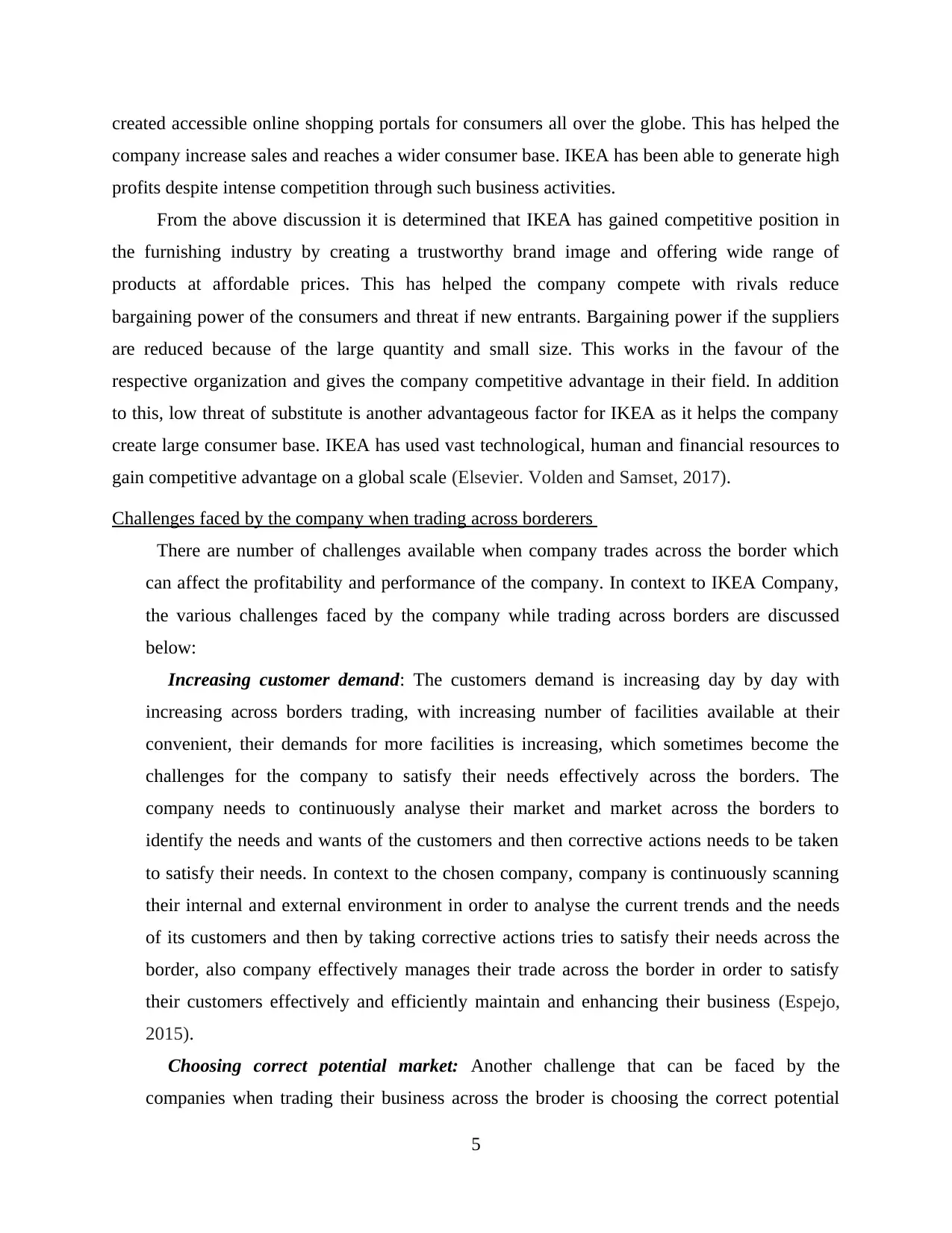
created accessible online shopping portals for consumers all over the globe. This has helped the
company increase sales and reaches a wider consumer base. IKEA has been able to generate high
profits despite intense competition through such business activities.
From the above discussion it is determined that IKEA has gained competitive position in
the furnishing industry by creating a trustworthy brand image and offering wide range of
products at affordable prices. This has helped the company compete with rivals reduce
bargaining power of the consumers and threat if new entrants. Bargaining power if the suppliers
are reduced because of the large quantity and small size. This works in the favour of the
respective organization and gives the company competitive advantage in their field. In addition
to this, low threat of substitute is another advantageous factor for IKEA as it helps the company
create large consumer base. IKEA has used vast technological, human and financial resources to
gain competitive advantage on a global scale (Elsevier. Volden and Samset, 2017).
Challenges faced by the company when trading across borderers
There are number of challenges available when company trades across the border which
can affect the profitability and performance of the company. In context to IKEA Company,
the various challenges faced by the company while trading across borders are discussed
below:
Increasing customer demand: The customers demand is increasing day by day with
increasing across borders trading, with increasing number of facilities available at their
convenient, their demands for more facilities is increasing, which sometimes become the
challenges for the company to satisfy their needs effectively across the borders. The
company needs to continuously analyse their market and market across the borders to
identify the needs and wants of the customers and then corrective actions needs to be taken
to satisfy their needs. In context to the chosen company, company is continuously scanning
their internal and external environment in order to analyse the current trends and the needs
of its customers and then by taking corrective actions tries to satisfy their needs across the
border, also company effectively manages their trade across the border in order to satisfy
their customers effectively and efficiently maintain and enhancing their business (Espejo,
2015).
Choosing correct potential market: Another challenge that can be faced by the
companies when trading their business across the broder is choosing the correct potential
5
company increase sales and reaches a wider consumer base. IKEA has been able to generate high
profits despite intense competition through such business activities.
From the above discussion it is determined that IKEA has gained competitive position in
the furnishing industry by creating a trustworthy brand image and offering wide range of
products at affordable prices. This has helped the company compete with rivals reduce
bargaining power of the consumers and threat if new entrants. Bargaining power if the suppliers
are reduced because of the large quantity and small size. This works in the favour of the
respective organization and gives the company competitive advantage in their field. In addition
to this, low threat of substitute is another advantageous factor for IKEA as it helps the company
create large consumer base. IKEA has used vast technological, human and financial resources to
gain competitive advantage on a global scale (Elsevier. Volden and Samset, 2017).
Challenges faced by the company when trading across borderers
There are number of challenges available when company trades across the border which
can affect the profitability and performance of the company. In context to IKEA Company,
the various challenges faced by the company while trading across borders are discussed
below:
Increasing customer demand: The customers demand is increasing day by day with
increasing across borders trading, with increasing number of facilities available at their
convenient, their demands for more facilities is increasing, which sometimes become the
challenges for the company to satisfy their needs effectively across the borders. The
company needs to continuously analyse their market and market across the borders to
identify the needs and wants of the customers and then corrective actions needs to be taken
to satisfy their needs. In context to the chosen company, company is continuously scanning
their internal and external environment in order to analyse the current trends and the needs
of its customers and then by taking corrective actions tries to satisfy their needs across the
border, also company effectively manages their trade across the border in order to satisfy
their customers effectively and efficiently maintain and enhancing their business (Espejo,
2015).
Choosing correct potential market: Another challenge that can be faced by the
companies when trading their business across the broder is choosing the correct potential
5
Paraphrase This Document
Need a fresh take? Get an instant paraphrase of this document with our AI Paraphraser
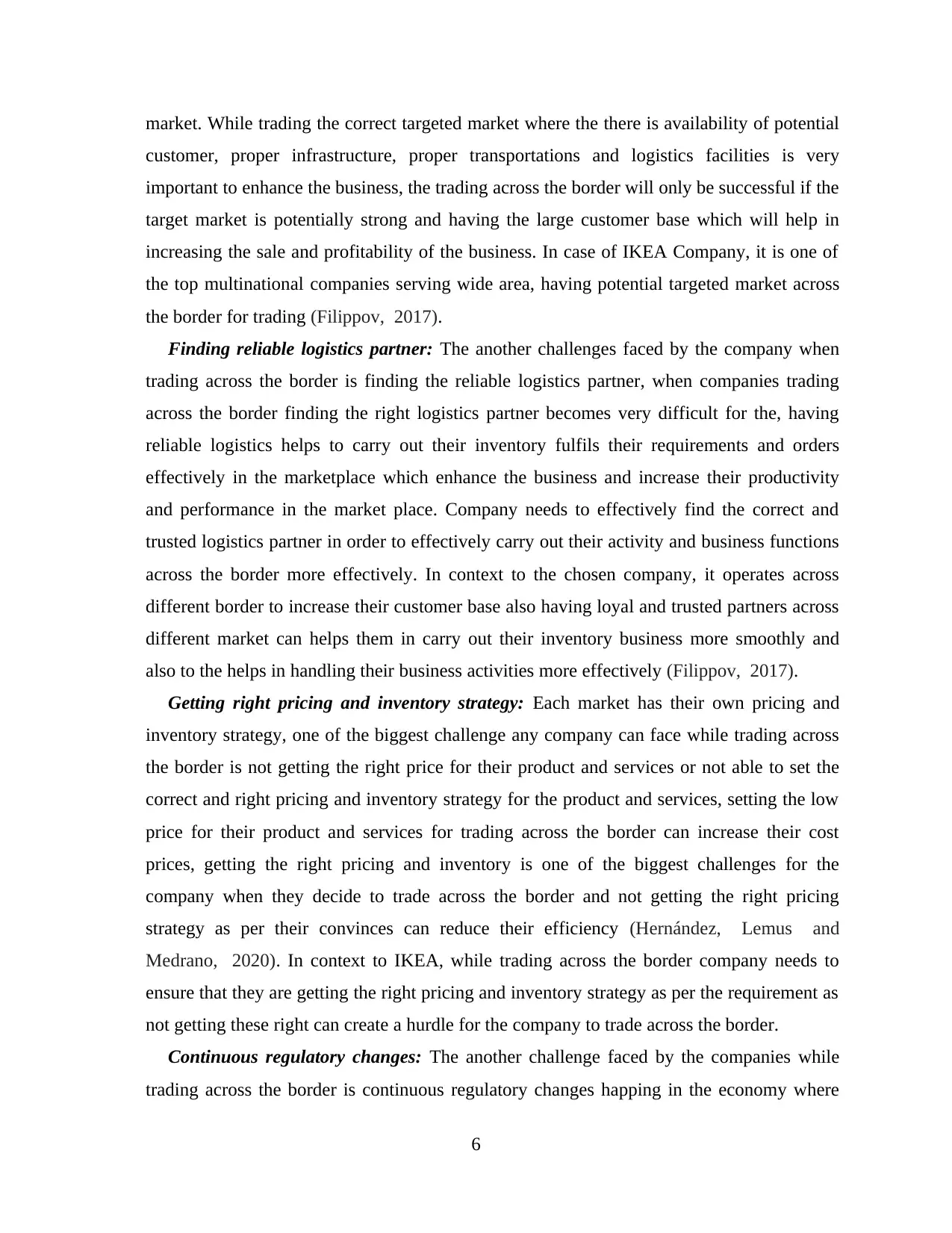
market. While trading the correct targeted market where the there is availability of potential
customer, proper infrastructure, proper transportations and logistics facilities is very
important to enhance the business, the trading across the border will only be successful if the
target market is potentially strong and having the large customer base which will help in
increasing the sale and profitability of the business. In case of IKEA Company, it is one of
the top multinational companies serving wide area, having potential targeted market across
the border for trading (Filippov, 2017).
Finding reliable logistics partner: The another challenges faced by the company when
trading across the border is finding the reliable logistics partner, when companies trading
across the border finding the right logistics partner becomes very difficult for the, having
reliable logistics helps to carry out their inventory fulfils their requirements and orders
effectively in the marketplace which enhance the business and increase their productivity
and performance in the market place. Company needs to effectively find the correct and
trusted logistics partner in order to effectively carry out their activity and business functions
across the border more effectively. In context to the chosen company, it operates across
different border to increase their customer base also having loyal and trusted partners across
different market can helps them in carry out their inventory business more smoothly and
also to the helps in handling their business activities more effectively (Filippov, 2017).
Getting right pricing and inventory strategy: Each market has their own pricing and
inventory strategy, one of the biggest challenge any company can face while trading across
the border is not getting the right price for their product and services or not able to set the
correct and right pricing and inventory strategy for the product and services, setting the low
price for their product and services for trading across the border can increase their cost
prices, getting the right pricing and inventory is one of the biggest challenges for the
company when they decide to trade across the border and not getting the right pricing
strategy as per their convinces can reduce their efficiency (Hernández, Lemus and
Medrano, 2020). In context to IKEA, while trading across the border company needs to
ensure that they are getting the right pricing and inventory strategy as per the requirement as
not getting these right can create a hurdle for the company to trade across the border.
Continuous regulatory changes: The another challenge faced by the companies while
trading across the border is continuous regulatory changes happing in the economy where
6
customer, proper infrastructure, proper transportations and logistics facilities is very
important to enhance the business, the trading across the border will only be successful if the
target market is potentially strong and having the large customer base which will help in
increasing the sale and profitability of the business. In case of IKEA Company, it is one of
the top multinational companies serving wide area, having potential targeted market across
the border for trading (Filippov, 2017).
Finding reliable logistics partner: The another challenges faced by the company when
trading across the border is finding the reliable logistics partner, when companies trading
across the border finding the right logistics partner becomes very difficult for the, having
reliable logistics helps to carry out their inventory fulfils their requirements and orders
effectively in the marketplace which enhance the business and increase their productivity
and performance in the market place. Company needs to effectively find the correct and
trusted logistics partner in order to effectively carry out their activity and business functions
across the border more effectively. In context to the chosen company, it operates across
different border to increase their customer base also having loyal and trusted partners across
different market can helps them in carry out their inventory business more smoothly and
also to the helps in handling their business activities more effectively (Filippov, 2017).
Getting right pricing and inventory strategy: Each market has their own pricing and
inventory strategy, one of the biggest challenge any company can face while trading across
the border is not getting the right price for their product and services or not able to set the
correct and right pricing and inventory strategy for the product and services, setting the low
price for their product and services for trading across the border can increase their cost
prices, getting the right pricing and inventory is one of the biggest challenges for the
company when they decide to trade across the border and not getting the right pricing
strategy as per their convinces can reduce their efficiency (Hernández, Lemus and
Medrano, 2020). In context to IKEA, while trading across the border company needs to
ensure that they are getting the right pricing and inventory strategy as per the requirement as
not getting these right can create a hurdle for the company to trade across the border.
Continuous regulatory changes: The another challenge faced by the companies while
trading across the border is continuous regulatory changes happing in the economy where
6
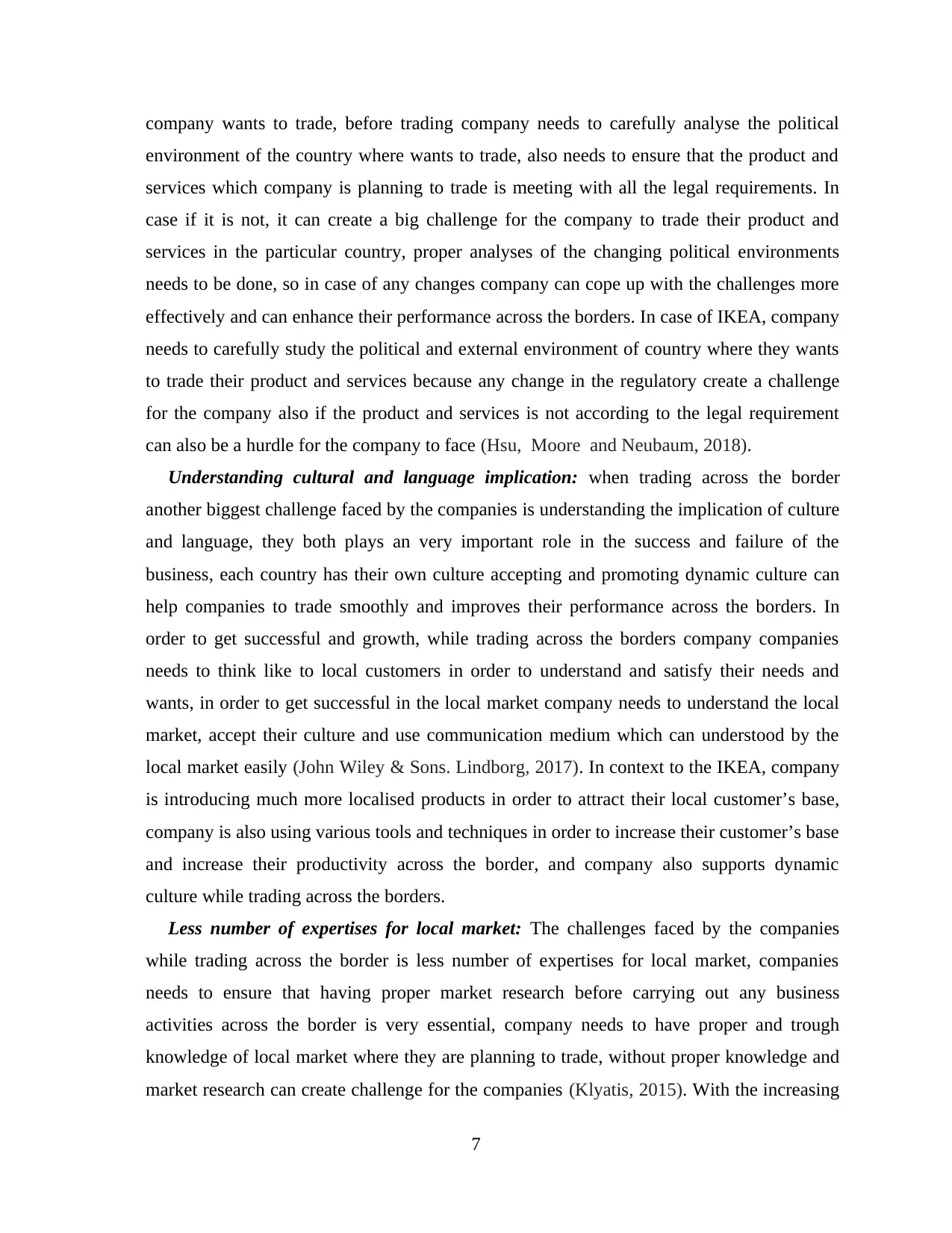
company wants to trade, before trading company needs to carefully analyse the political
environment of the country where wants to trade, also needs to ensure that the product and
services which company is planning to trade is meeting with all the legal requirements. In
case if it is not, it can create a big challenge for the company to trade their product and
services in the particular country, proper analyses of the changing political environments
needs to be done, so in case of any changes company can cope up with the challenges more
effectively and can enhance their performance across the borders. In case of IKEA, company
needs to carefully study the political and external environment of country where they wants
to trade their product and services because any change in the regulatory create a challenge
for the company also if the product and services is not according to the legal requirement
can also be a hurdle for the company to face (Hsu, Moore and Neubaum, 2018).
Understanding cultural and language implication: when trading across the border
another biggest challenge faced by the companies is understanding the implication of culture
and language, they both plays an very important role in the success and failure of the
business, each country has their own culture accepting and promoting dynamic culture can
help companies to trade smoothly and improves their performance across the borders. In
order to get successful and growth, while trading across the borders company companies
needs to think like to local customers in order to understand and satisfy their needs and
wants, in order to get successful in the local market company needs to understand the local
market, accept their culture and use communication medium which can understood by the
local market easily (John Wiley & Sons. Lindborg, 2017). In context to the IKEA, company
is introducing much more localised products in order to attract their local customer’s base,
company is also using various tools and techniques in order to increase their customer’s base
and increase their productivity across the border, and company also supports dynamic
culture while trading across the borders.
Less number of expertises for local market: The challenges faced by the companies
while trading across the border is less number of expertises for local market, companies
needs to ensure that having proper market research before carrying out any business
activities across the border is very essential, company needs to have proper and trough
knowledge of local market where they are planning to trade, without proper knowledge and
market research can create challenge for the companies (Klyatis, 2015). With the increasing
7
environment of the country where wants to trade, also needs to ensure that the product and
services which company is planning to trade is meeting with all the legal requirements. In
case if it is not, it can create a big challenge for the company to trade their product and
services in the particular country, proper analyses of the changing political environments
needs to be done, so in case of any changes company can cope up with the challenges more
effectively and can enhance their performance across the borders. In case of IKEA, company
needs to carefully study the political and external environment of country where they wants
to trade their product and services because any change in the regulatory create a challenge
for the company also if the product and services is not according to the legal requirement
can also be a hurdle for the company to face (Hsu, Moore and Neubaum, 2018).
Understanding cultural and language implication: when trading across the border
another biggest challenge faced by the companies is understanding the implication of culture
and language, they both plays an very important role in the success and failure of the
business, each country has their own culture accepting and promoting dynamic culture can
help companies to trade smoothly and improves their performance across the borders. In
order to get successful and growth, while trading across the borders company companies
needs to think like to local customers in order to understand and satisfy their needs and
wants, in order to get successful in the local market company needs to understand the local
market, accept their culture and use communication medium which can understood by the
local market easily (John Wiley & Sons. Lindborg, 2017). In context to the IKEA, company
is introducing much more localised products in order to attract their local customer’s base,
company is also using various tools and techniques in order to increase their customer’s base
and increase their productivity across the border, and company also supports dynamic
culture while trading across the borders.
Less number of expertises for local market: The challenges faced by the companies
while trading across the border is less number of expertises for local market, companies
needs to ensure that having proper market research before carrying out any business
activities across the border is very essential, company needs to have proper and trough
knowledge of local market where they are planning to trade, without proper knowledge and
market research can create challenge for the companies (Klyatis, 2015). With the increasing
7
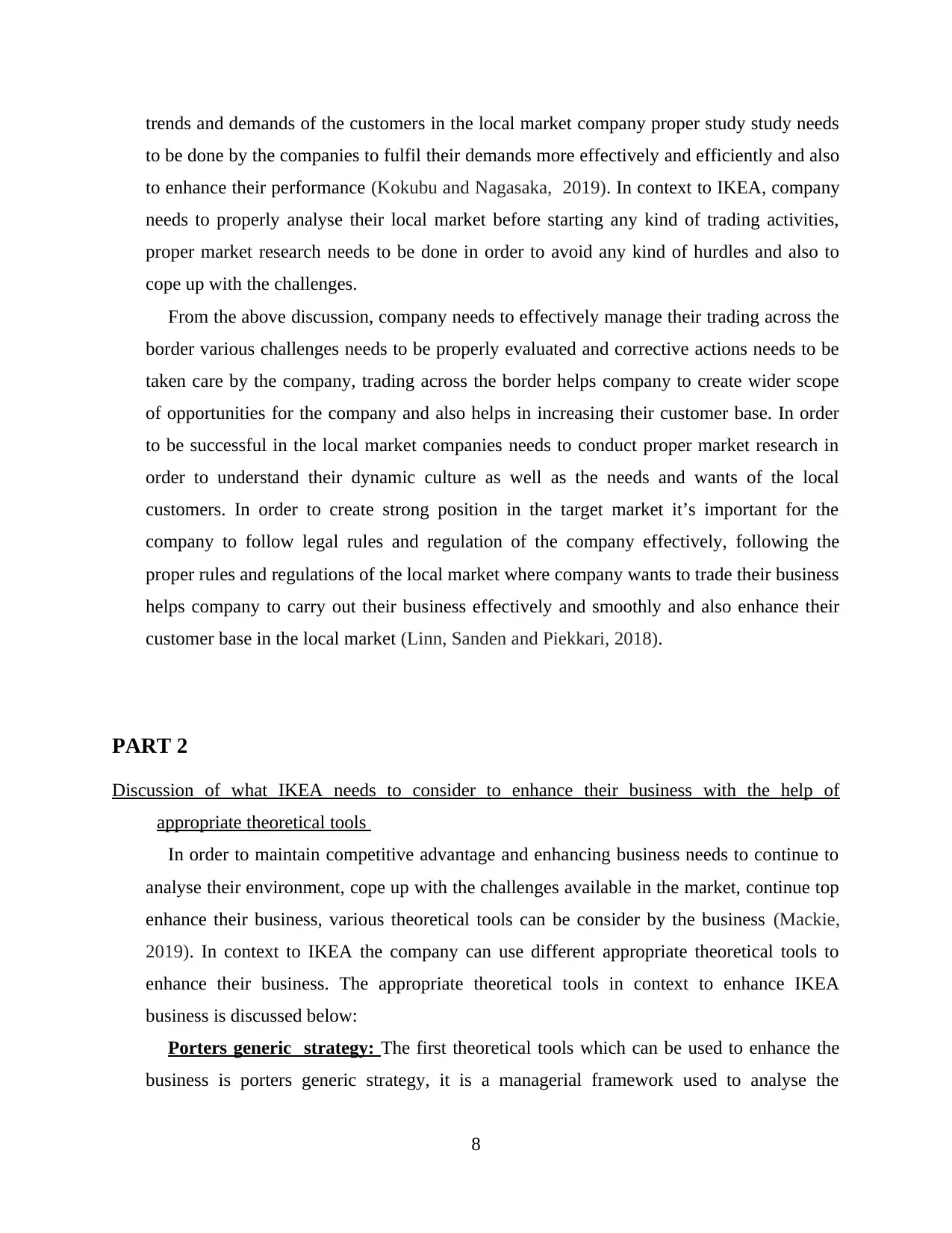
trends and demands of the customers in the local market company proper study study needs
to be done by the companies to fulfil their demands more effectively and efficiently and also
to enhance their performance (Kokubu and Nagasaka, 2019). In context to IKEA, company
needs to properly analyse their local market before starting any kind of trading activities,
proper market research needs to be done in order to avoid any kind of hurdles and also to
cope up with the challenges.
From the above discussion, company needs to effectively manage their trading across the
border various challenges needs to be properly evaluated and corrective actions needs to be
taken care by the company, trading across the border helps company to create wider scope
of opportunities for the company and also helps in increasing their customer base. In order
to be successful in the local market companies needs to conduct proper market research in
order to understand their dynamic culture as well as the needs and wants of the local
customers. In order to create strong position in the target market it’s important for the
company to follow legal rules and regulation of the company effectively, following the
proper rules and regulations of the local market where company wants to trade their business
helps company to carry out their business effectively and smoothly and also enhance their
customer base in the local market (Linn, Sanden and Piekkari, 2018).
PART 2
Discussion of what IKEA needs to consider to enhance their business with the help of
appropriate theoretical tools
In order to maintain competitive advantage and enhancing business needs to continue to
analyse their environment, cope up with the challenges available in the market, continue top
enhance their business, various theoretical tools can be consider by the business (Mackie,
2019). In context to IKEA the company can use different appropriate theoretical tools to
enhance their business. The appropriate theoretical tools in context to enhance IKEA
business is discussed below:
Porters generic strategy: The first theoretical tools which can be used to enhance the
business is porters generic strategy, it is a managerial framework used to analyse the
8
to be done by the companies to fulfil their demands more effectively and efficiently and also
to enhance their performance (Kokubu and Nagasaka, 2019). In context to IKEA, company
needs to properly analyse their local market before starting any kind of trading activities,
proper market research needs to be done in order to avoid any kind of hurdles and also to
cope up with the challenges.
From the above discussion, company needs to effectively manage their trading across the
border various challenges needs to be properly evaluated and corrective actions needs to be
taken care by the company, trading across the border helps company to create wider scope
of opportunities for the company and also helps in increasing their customer base. In order
to be successful in the local market companies needs to conduct proper market research in
order to understand their dynamic culture as well as the needs and wants of the local
customers. In order to create strong position in the target market it’s important for the
company to follow legal rules and regulation of the company effectively, following the
proper rules and regulations of the local market where company wants to trade their business
helps company to carry out their business effectively and smoothly and also enhance their
customer base in the local market (Linn, Sanden and Piekkari, 2018).
PART 2
Discussion of what IKEA needs to consider to enhance their business with the help of
appropriate theoretical tools
In order to maintain competitive advantage and enhancing business needs to continue to
analyse their environment, cope up with the challenges available in the market, continue top
enhance their business, various theoretical tools can be consider by the business (Mackie,
2019). In context to IKEA the company can use different appropriate theoretical tools to
enhance their business. The appropriate theoretical tools in context to enhance IKEA
business is discussed below:
Porters generic strategy: The first theoretical tools which can be used to enhance the
business is porters generic strategy, it is a managerial framework used to analyse the
8
Secure Best Marks with AI Grader
Need help grading? Try our AI Grader for instant feedback on your assignments.
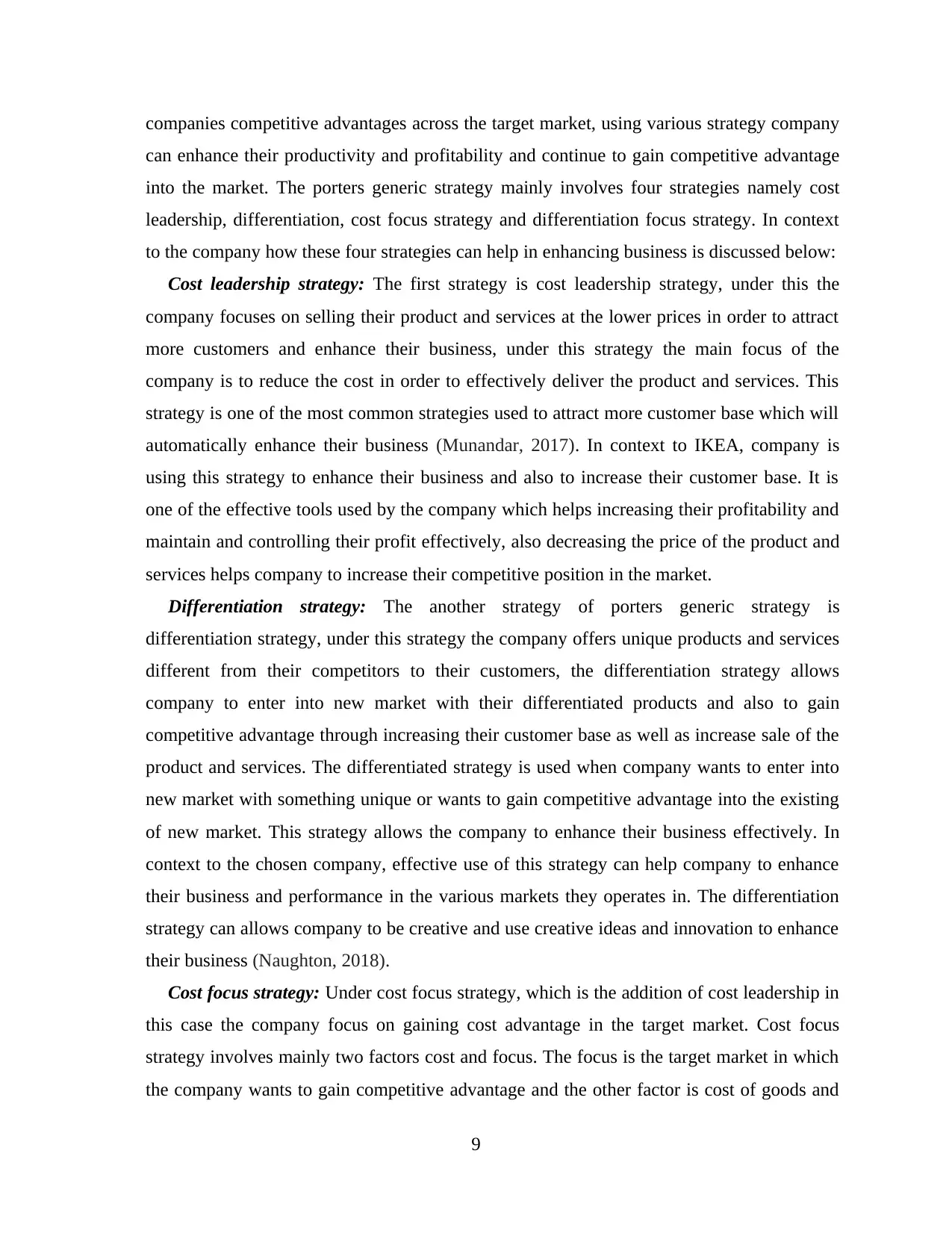
companies competitive advantages across the target market, using various strategy company
can enhance their productivity and profitability and continue to gain competitive advantage
into the market. The porters generic strategy mainly involves four strategies namely cost
leadership, differentiation, cost focus strategy and differentiation focus strategy. In context
to the company how these four strategies can help in enhancing business is discussed below:
Cost leadership strategy: The first strategy is cost leadership strategy, under this the
company focuses on selling their product and services at the lower prices in order to attract
more customers and enhance their business, under this strategy the main focus of the
company is to reduce the cost in order to effectively deliver the product and services. This
strategy is one of the most common strategies used to attract more customer base which will
automatically enhance their business (Munandar, 2017). In context to IKEA, company is
using this strategy to enhance their business and also to increase their customer base. It is
one of the effective tools used by the company which helps increasing their profitability and
maintain and controlling their profit effectively, also decreasing the price of the product and
services helps company to increase their competitive position in the market.
Differentiation strategy: The another strategy of porters generic strategy is
differentiation strategy, under this strategy the company offers unique products and services
different from their competitors to their customers, the differentiation strategy allows
company to enter into new market with their differentiated products and also to gain
competitive advantage through increasing their customer base as well as increase sale of the
product and services. The differentiated strategy is used when company wants to enter into
new market with something unique or wants to gain competitive advantage into the existing
of new market. This strategy allows the company to enhance their business effectively. In
context to the chosen company, effective use of this strategy can help company to enhance
their business and performance in the various markets they operates in. The differentiation
strategy can allows company to be creative and use creative ideas and innovation to enhance
their business (Naughton, 2018).
Cost focus strategy: Under cost focus strategy, which is the addition of cost leadership in
this case the company focus on gaining cost advantage in the target market. Cost focus
strategy involves mainly two factors cost and focus. The focus is the target market in which
the company wants to gain competitive advantage and the other factor is cost of goods and
9
can enhance their productivity and profitability and continue to gain competitive advantage
into the market. The porters generic strategy mainly involves four strategies namely cost
leadership, differentiation, cost focus strategy and differentiation focus strategy. In context
to the company how these four strategies can help in enhancing business is discussed below:
Cost leadership strategy: The first strategy is cost leadership strategy, under this the
company focuses on selling their product and services at the lower prices in order to attract
more customers and enhance their business, under this strategy the main focus of the
company is to reduce the cost in order to effectively deliver the product and services. This
strategy is one of the most common strategies used to attract more customer base which will
automatically enhance their business (Munandar, 2017). In context to IKEA, company is
using this strategy to enhance their business and also to increase their customer base. It is
one of the effective tools used by the company which helps increasing their profitability and
maintain and controlling their profit effectively, also decreasing the price of the product and
services helps company to increase their competitive position in the market.
Differentiation strategy: The another strategy of porters generic strategy is
differentiation strategy, under this strategy the company offers unique products and services
different from their competitors to their customers, the differentiation strategy allows
company to enter into new market with their differentiated products and also to gain
competitive advantage through increasing their customer base as well as increase sale of the
product and services. The differentiated strategy is used when company wants to enter into
new market with something unique or wants to gain competitive advantage into the existing
of new market. This strategy allows the company to enhance their business effectively. In
context to the chosen company, effective use of this strategy can help company to enhance
their business and performance in the various markets they operates in. The differentiation
strategy can allows company to be creative and use creative ideas and innovation to enhance
their business (Naughton, 2018).
Cost focus strategy: Under cost focus strategy, which is the addition of cost leadership in
this case the company focus on gaining cost advantage in the target market. Cost focus
strategy involves mainly two factors cost and focus. The focus is the target market in which
the company wants to gain competitive advantage and the other factor is cost of goods and
9
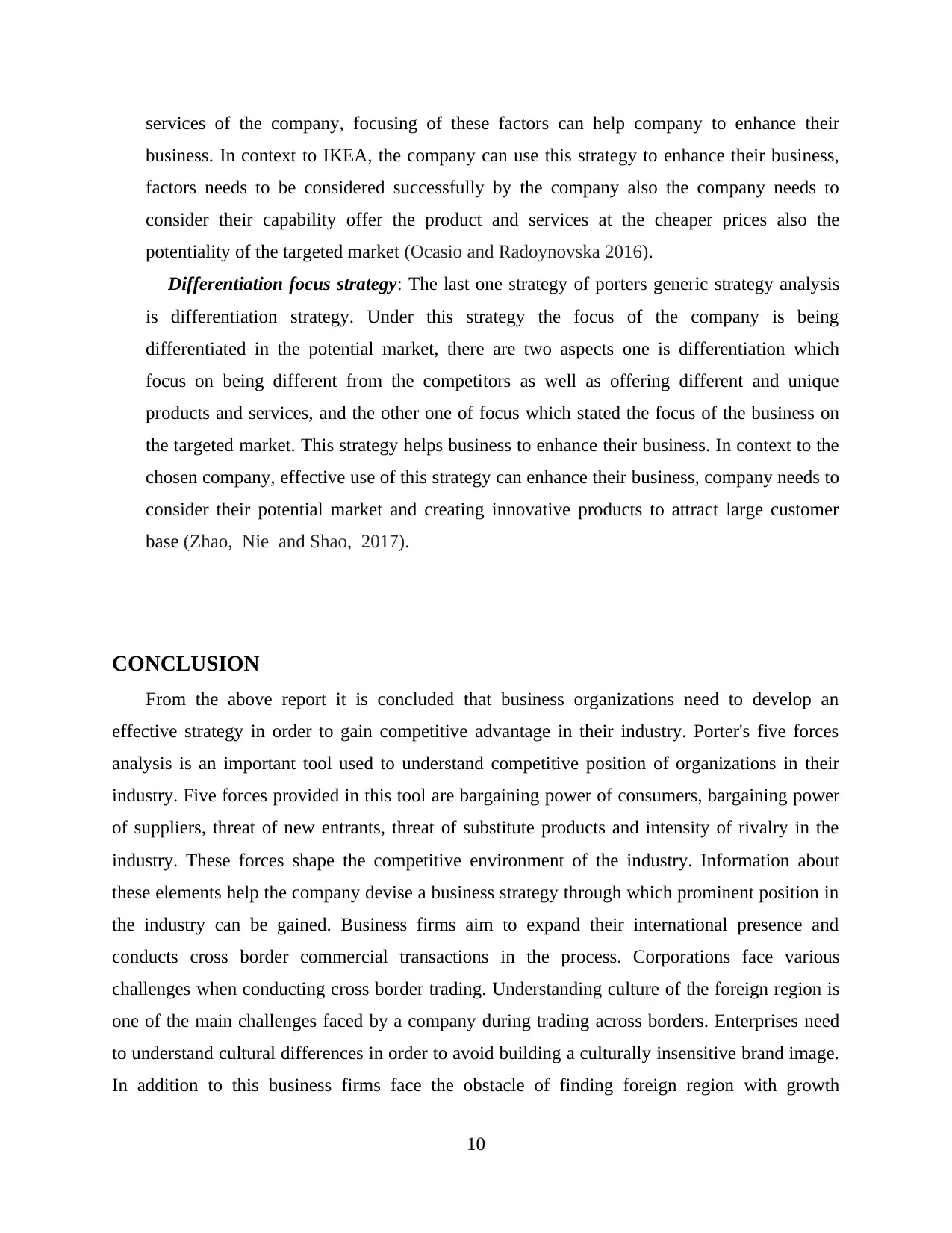
services of the company, focusing of these factors can help company to enhance their
business. In context to IKEA, the company can use this strategy to enhance their business,
factors needs to be considered successfully by the company also the company needs to
consider their capability offer the product and services at the cheaper prices also the
potentiality of the targeted market (Ocasio and Radoynovska 2016).
Differentiation focus strategy: The last one strategy of porters generic strategy analysis
is differentiation strategy. Under this strategy the focus of the company is being
differentiated in the potential market, there are two aspects one is differentiation which
focus on being different from the competitors as well as offering different and unique
products and services, and the other one of focus which stated the focus of the business on
the targeted market. This strategy helps business to enhance their business. In context to the
chosen company, effective use of this strategy can enhance their business, company needs to
consider their potential market and creating innovative products to attract large customer
base (Zhao, Nie and Shao, 2017).
CONCLUSION
From the above report it is concluded that business organizations need to develop an
effective strategy in order to gain competitive advantage in their industry. Porter's five forces
analysis is an important tool used to understand competitive position of organizations in their
industry. Five forces provided in this tool are bargaining power of consumers, bargaining power
of suppliers, threat of new entrants, threat of substitute products and intensity of rivalry in the
industry. These forces shape the competitive environment of the industry. Information about
these elements help the company devise a business strategy through which prominent position in
the industry can be gained. Business firms aim to expand their international presence and
conducts cross border commercial transactions in the process. Corporations face various
challenges when conducting cross border trading. Understanding culture of the foreign region is
one of the main challenges faced by a company during trading across borders. Enterprises need
to understand cultural differences in order to avoid building a culturally insensitive brand image.
In addition to this business firms face the obstacle of finding foreign region with growth
10
business. In context to IKEA, the company can use this strategy to enhance their business,
factors needs to be considered successfully by the company also the company needs to
consider their capability offer the product and services at the cheaper prices also the
potentiality of the targeted market (Ocasio and Radoynovska 2016).
Differentiation focus strategy: The last one strategy of porters generic strategy analysis
is differentiation strategy. Under this strategy the focus of the company is being
differentiated in the potential market, there are two aspects one is differentiation which
focus on being different from the competitors as well as offering different and unique
products and services, and the other one of focus which stated the focus of the business on
the targeted market. This strategy helps business to enhance their business. In context to the
chosen company, effective use of this strategy can enhance their business, company needs to
consider their potential market and creating innovative products to attract large customer
base (Zhao, Nie and Shao, 2017).
CONCLUSION
From the above report it is concluded that business organizations need to develop an
effective strategy in order to gain competitive advantage in their industry. Porter's five forces
analysis is an important tool used to understand competitive position of organizations in their
industry. Five forces provided in this tool are bargaining power of consumers, bargaining power
of suppliers, threat of new entrants, threat of substitute products and intensity of rivalry in the
industry. These forces shape the competitive environment of the industry. Information about
these elements help the company devise a business strategy through which prominent position in
the industry can be gained. Business firms aim to expand their international presence and
conducts cross border commercial transactions in the process. Corporations face various
challenges when conducting cross border trading. Understanding culture of the foreign region is
one of the main challenges faced by a company during trading across borders. Enterprises need
to understand cultural differences in order to avoid building a culturally insensitive brand image.
In addition to this business firms face the obstacle of finding foreign region with growth
10
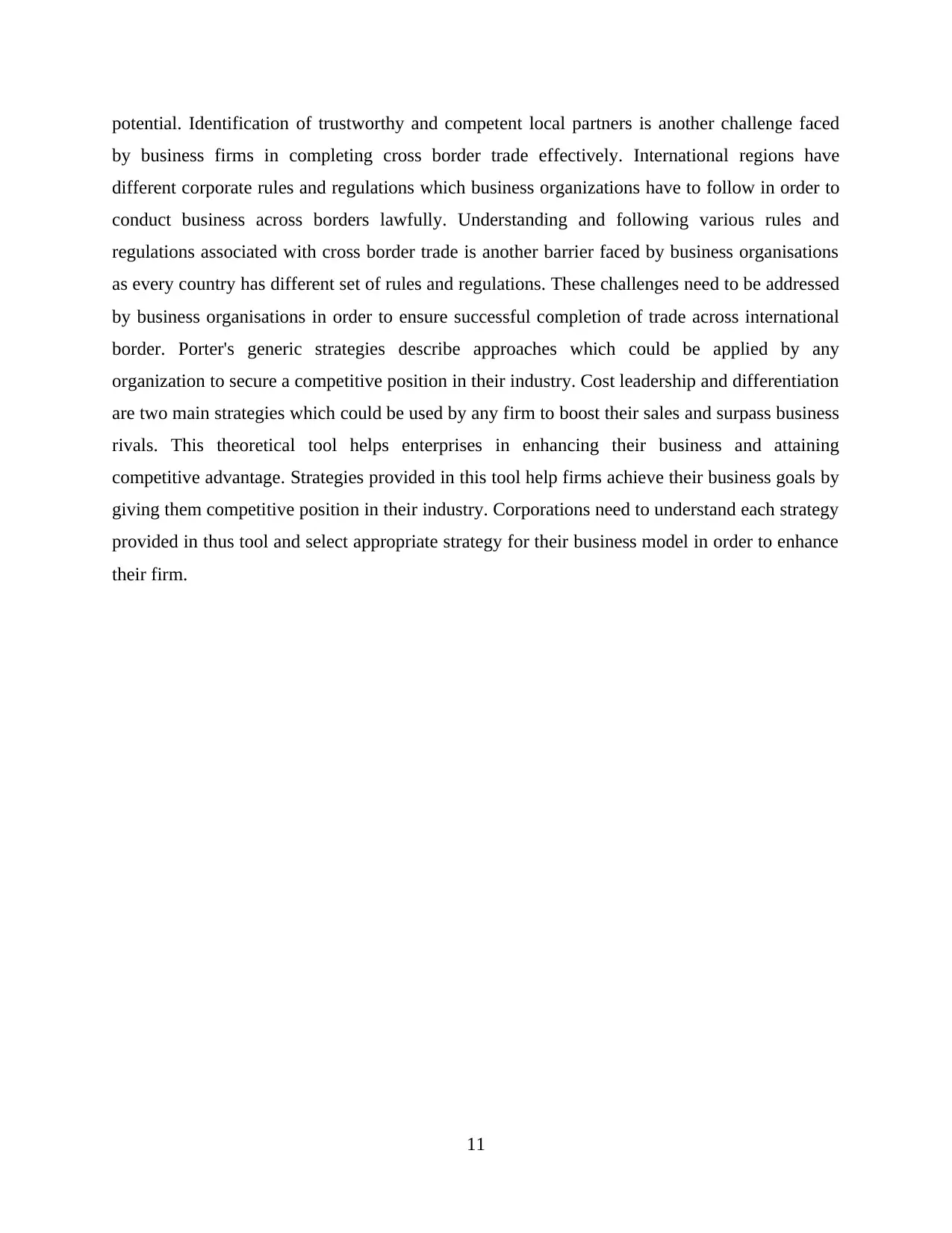
potential. Identification of trustworthy and competent local partners is another challenge faced
by business firms in completing cross border trade effectively. International regions have
different corporate rules and regulations which business organizations have to follow in order to
conduct business across borders lawfully. Understanding and following various rules and
regulations associated with cross border trade is another barrier faced by business organisations
as every country has different set of rules and regulations. These challenges need to be addressed
by business organisations in order to ensure successful completion of trade across international
border. Porter's generic strategies describe approaches which could be applied by any
organization to secure a competitive position in their industry. Cost leadership and differentiation
are two main strategies which could be used by any firm to boost their sales and surpass business
rivals. This theoretical tool helps enterprises in enhancing their business and attaining
competitive advantage. Strategies provided in this tool help firms achieve their business goals by
giving them competitive position in their industry. Corporations need to understand each strategy
provided in thus tool and select appropriate strategy for their business model in order to enhance
their firm.
11
by business firms in completing cross border trade effectively. International regions have
different corporate rules and regulations which business organizations have to follow in order to
conduct business across borders lawfully. Understanding and following various rules and
regulations associated with cross border trade is another barrier faced by business organisations
as every country has different set of rules and regulations. These challenges need to be addressed
by business organisations in order to ensure successful completion of trade across international
border. Porter's generic strategies describe approaches which could be applied by any
organization to secure a competitive position in their industry. Cost leadership and differentiation
are two main strategies which could be used by any firm to boost their sales and surpass business
rivals. This theoretical tool helps enterprises in enhancing their business and attaining
competitive advantage. Strategies provided in this tool help firms achieve their business goals by
giving them competitive position in their industry. Corporations need to understand each strategy
provided in thus tool and select appropriate strategy for their business model in order to enhance
their firm.
11
Paraphrase This Document
Need a fresh take? Get an instant paraphrase of this document with our AI Paraphraser
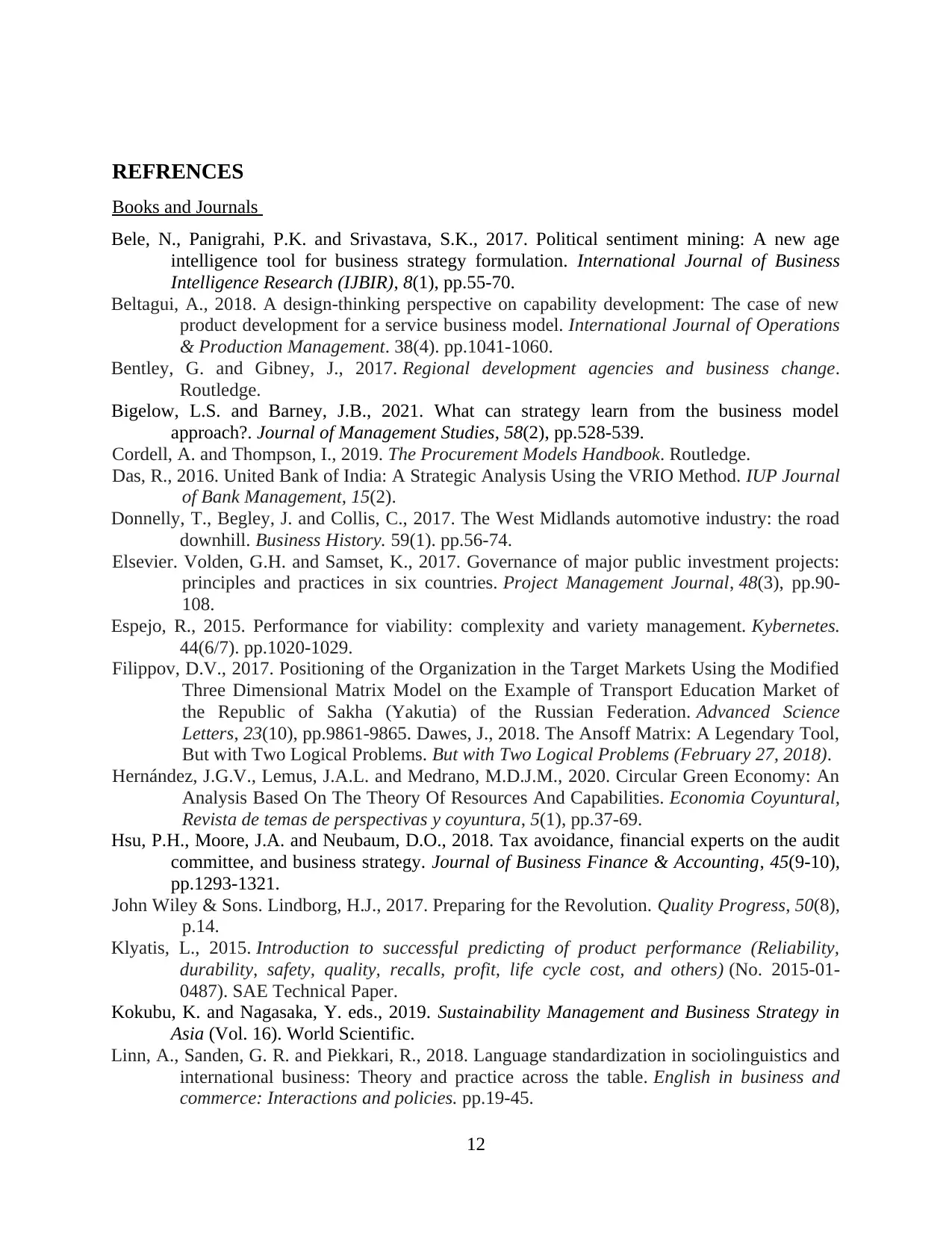
REFRENCES
Books and Journals
Bele, N., Panigrahi, P.K. and Srivastava, S.K., 2017. Political sentiment mining: A new age
intelligence tool for business strategy formulation. International Journal of Business
Intelligence Research (IJBIR), 8(1), pp.55-70.
Beltagui, A., 2018. A design-thinking perspective on capability development: The case of new
product development for a service business model. International Journal of Operations
& Production Management. 38(4). pp.1041-1060.
Bentley, G. and Gibney, J., 2017. Regional development agencies and business change.
Routledge.
Bigelow, L.S. and Barney, J.B., 2021. What can strategy learn from the business model
approach?. Journal of Management Studies, 58(2), pp.528-539.
Cordell, A. and Thompson, I., 2019. The Procurement Models Handbook. Routledge.
Das, R., 2016. United Bank of India: A Strategic Analysis Using the VRIO Method. IUP Journal
of Bank Management, 15(2).
Donnelly, T., Begley, J. and Collis, C., 2017. The West Midlands automotive industry: the road
downhill. Business History. 59(1). pp.56-74.
Elsevier. Volden, G.H. and Samset, K., 2017. Governance of major public investment projects:
principles and practices in six countries. Project Management Journal, 48(3), pp.90-
108.
Espejo, R., 2015. Performance for viability: complexity and variety management. Kybernetes.
44(6/7). pp.1020-1029.
Filippov, D.V., 2017. Positioning of the Organization in the Target Markets Using the Modified
Three Dimensional Matrix Model on the Example of Transport Education Market of
the Republic of Sakha (Yakutia) of the Russian Federation. Advanced Science
Letters, 23(10), pp.9861-9865. Dawes, J., 2018. The Ansoff Matrix: A Legendary Tool,
But with Two Logical Problems. But with Two Logical Problems (February 27, 2018).
Hernández, J.G.V., Lemus, J.A.L. and Medrano, M.D.J.M., 2020. Circular Green Economy: An
Analysis Based On The Theory Of Resources And Capabilities. Economia Coyuntural,
Revista de temas de perspectivas y coyuntura, 5(1), pp.37-69.
Hsu, P.H., Moore, J.A. and Neubaum, D.O., 2018. Tax avoidance, financial experts on the audit
committee, and business strategy. Journal of Business Finance & Accounting, 45(9-10),
pp.1293-1321.
John Wiley & Sons. Lindborg, H.J., 2017. Preparing for the Revolution. Quality Progress, 50(8),
p.14.
Klyatis, L., 2015. Introduction to successful predicting of product performance (Reliability,
durability, safety, quality, recalls, profit, life cycle cost, and others) (No. 2015-01-
0487). SAE Technical Paper.
Kokubu, K. and Nagasaka, Y. eds., 2019. Sustainability Management and Business Strategy in
Asia (Vol. 16). World Scientific.
Linn, A., Sanden, G. R. and Piekkari, R., 2018. Language standardization in sociolinguistics and
international business: Theory and practice across the table. English in business and
commerce: Interactions and policies. pp.19-45.
12
Books and Journals
Bele, N., Panigrahi, P.K. and Srivastava, S.K., 2017. Political sentiment mining: A new age
intelligence tool for business strategy formulation. International Journal of Business
Intelligence Research (IJBIR), 8(1), pp.55-70.
Beltagui, A., 2018. A design-thinking perspective on capability development: The case of new
product development for a service business model. International Journal of Operations
& Production Management. 38(4). pp.1041-1060.
Bentley, G. and Gibney, J., 2017. Regional development agencies and business change.
Routledge.
Bigelow, L.S. and Barney, J.B., 2021. What can strategy learn from the business model
approach?. Journal of Management Studies, 58(2), pp.528-539.
Cordell, A. and Thompson, I., 2019. The Procurement Models Handbook. Routledge.
Das, R., 2016. United Bank of India: A Strategic Analysis Using the VRIO Method. IUP Journal
of Bank Management, 15(2).
Donnelly, T., Begley, J. and Collis, C., 2017. The West Midlands automotive industry: the road
downhill. Business History. 59(1). pp.56-74.
Elsevier. Volden, G.H. and Samset, K., 2017. Governance of major public investment projects:
principles and practices in six countries. Project Management Journal, 48(3), pp.90-
108.
Espejo, R., 2015. Performance for viability: complexity and variety management. Kybernetes.
44(6/7). pp.1020-1029.
Filippov, D.V., 2017. Positioning of the Organization in the Target Markets Using the Modified
Three Dimensional Matrix Model on the Example of Transport Education Market of
the Republic of Sakha (Yakutia) of the Russian Federation. Advanced Science
Letters, 23(10), pp.9861-9865. Dawes, J., 2018. The Ansoff Matrix: A Legendary Tool,
But with Two Logical Problems. But with Two Logical Problems (February 27, 2018).
Hernández, J.G.V., Lemus, J.A.L. and Medrano, M.D.J.M., 2020. Circular Green Economy: An
Analysis Based On The Theory Of Resources And Capabilities. Economia Coyuntural,
Revista de temas de perspectivas y coyuntura, 5(1), pp.37-69.
Hsu, P.H., Moore, J.A. and Neubaum, D.O., 2018. Tax avoidance, financial experts on the audit
committee, and business strategy. Journal of Business Finance & Accounting, 45(9-10),
pp.1293-1321.
John Wiley & Sons. Lindborg, H.J., 2017. Preparing for the Revolution. Quality Progress, 50(8),
p.14.
Klyatis, L., 2015. Introduction to successful predicting of product performance (Reliability,
durability, safety, quality, recalls, profit, life cycle cost, and others) (No. 2015-01-
0487). SAE Technical Paper.
Kokubu, K. and Nagasaka, Y. eds., 2019. Sustainability Management and Business Strategy in
Asia (Vol. 16). World Scientific.
Linn, A., Sanden, G. R. and Piekkari, R., 2018. Language standardization in sociolinguistics and
international business: Theory and practice across the table. English in business and
commerce: Interactions and policies. pp.19-45.
12
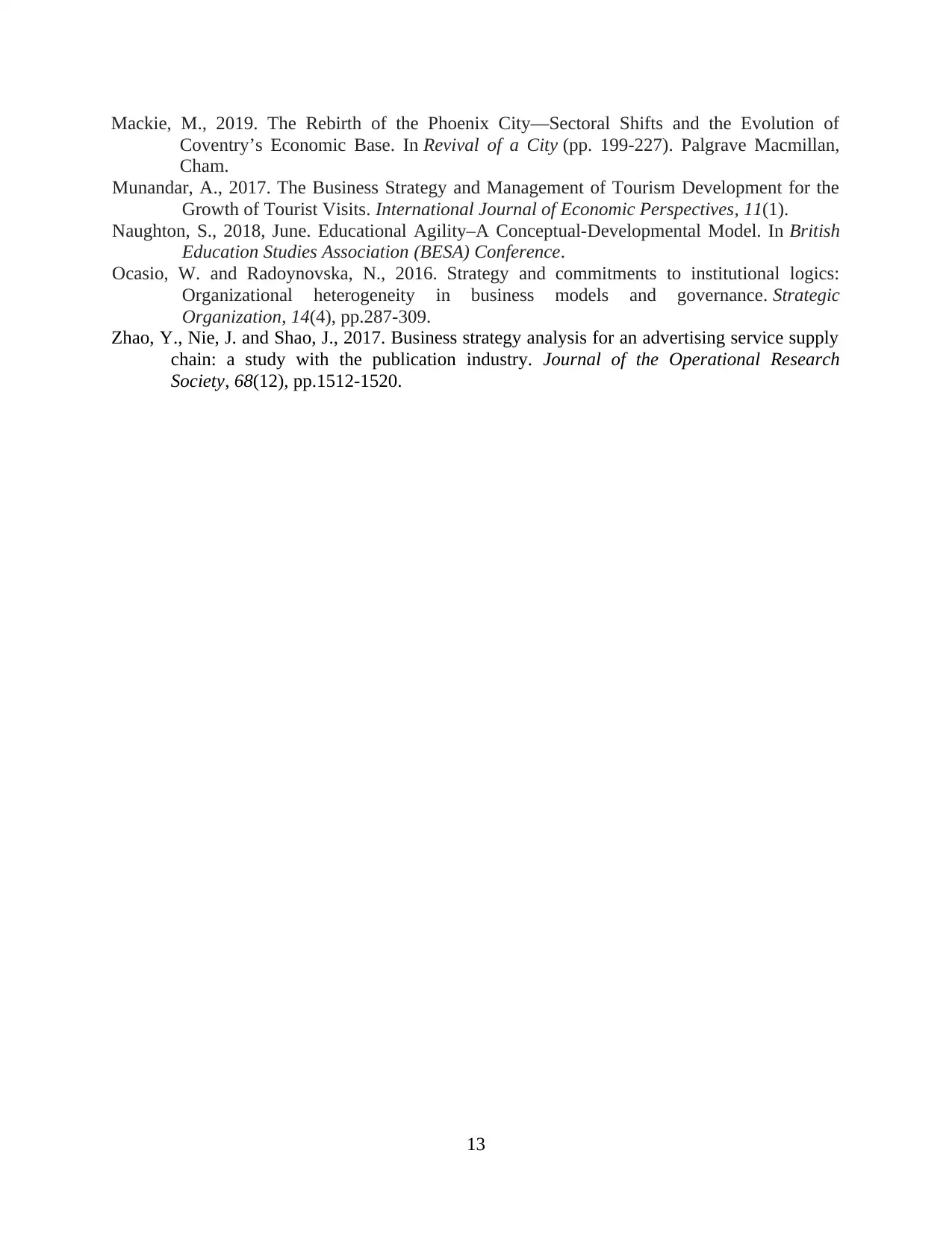
Mackie, M., 2019. The Rebirth of the Phoenix City—Sectoral Shifts and the Evolution of
Coventry’s Economic Base. In Revival of a City (pp. 199-227). Palgrave Macmillan,
Cham.
Munandar, A., 2017. The Business Strategy and Management of Tourism Development for the
Growth of Tourist Visits. International Journal of Economic Perspectives, 11(1).
Naughton, S., 2018, June. Educational Agility–A Conceptual-Developmental Model. In British
Education Studies Association (BESA) Conference.
Ocasio, W. and Radoynovska, N., 2016. Strategy and commitments to institutional logics:
Organizational heterogeneity in business models and governance. Strategic
Organization, 14(4), pp.287-309.
Zhao, Y., Nie, J. and Shao, J., 2017. Business strategy analysis for an advertising service supply
chain: a study with the publication industry. Journal of the Operational Research
Society, 68(12), pp.1512-1520.
13
Coventry’s Economic Base. In Revival of a City (pp. 199-227). Palgrave Macmillan,
Cham.
Munandar, A., 2017. The Business Strategy and Management of Tourism Development for the
Growth of Tourist Visits. International Journal of Economic Perspectives, 11(1).
Naughton, S., 2018, June. Educational Agility–A Conceptual-Developmental Model. In British
Education Studies Association (BESA) Conference.
Ocasio, W. and Radoynovska, N., 2016. Strategy and commitments to institutional logics:
Organizational heterogeneity in business models and governance. Strategic
Organization, 14(4), pp.287-309.
Zhao, Y., Nie, J. and Shao, J., 2017. Business strategy analysis for an advertising service supply
chain: a study with the publication industry. Journal of the Operational Research
Society, 68(12), pp.1512-1520.
13
1 out of 15
Related Documents
Your All-in-One AI-Powered Toolkit for Academic Success.
+13062052269
info@desklib.com
Available 24*7 on WhatsApp / Email
![[object Object]](/_next/static/media/star-bottom.7253800d.svg)
Unlock your academic potential
© 2024 | Zucol Services PVT LTD | All rights reserved.





